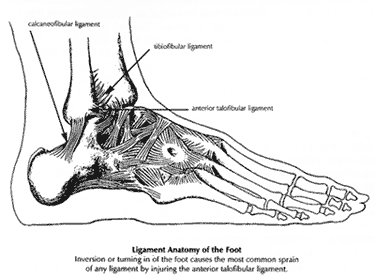What is an Ankle Sprain?
 An ankle sprain is an injury to one or more ligaments in the ankle, usually on the outside of the ankle. Ligaments are bands of tissue—like rubber bands—that connect one bone to another and bind the joints together. In the ankle joint, ligaments provide stability by limiting side-to-side movement.
An ankle sprain is an injury to one or more ligaments in the ankle, usually on the outside of the ankle. Ligaments are bands of tissue—like rubber bands—that connect one bone to another and bind the joints together. In the ankle joint, ligaments provide stability by limiting side-to-side movement.
Some ankle sprains are much worse than others. The severity of an ankle sprain depends on whether the ligament is stretched, partially torn, or completely torn, as well as on the number of ligaments involved. Ankle sprains are not the same as strains, which affect muscles rather than ligaments.
Signs & Symptoms
The signs and symptoms of ankle sprains may include:
- Pain or soreness
- Swelling
- Bruising
- Difficulty walking
- Stiffness in the joint
These symptoms may vary in intensity, depending on the severity of the sprain. Sometimes pain and swelling are absent in people with previous ankle sprains—instead, they may simply feel the ankle is wobbly and unsteady when they walk. Even if you don’t have pain or swelling with a sprained ankle, treatment is crucial. Any ankle sprain—whether it’s your first or your fifth—requires prompt medical attention.
Getting Treatment for Ankle Pain
There are four key reasons why an ankle sprain should be promptly evaluated and treated by a foot and ankle surgeon:
- An untreated ankle sprain may lead to chronic ankle instability, a condition marked by persistent discomfort and a “giving way” of the ankle. You may also develop weakness in the leg.
- You may have suffered a more severe ankle injury along with the sprain. This might include a serious bone fracture that could lead to troubling complications if it goes untreated.
- An ankle sprain may be accompanied by a foot injury that causes discomfort but has gone unnoticed thus far.
- Rehabilitation of a sprained ankle needs to begin right away. If rehabilitation is delayed, the injury may be less likely to heal properly.
In evaluating your injury, the foot and ankle surgeon will take your history to learn more about the injury. He or she will examine the injured area, and may order x-rays, an MRI study, or a CT scan to help determine the severity of the injury.
Non-Surgical Treatment for Ankle Pain
When you have an ankle sprain, rehabilitation is crucial—and it starts the moment your treatment begins. Your foot and ankle surgeon may recommend one or more of the following treatment options:
- Immobilization . Depending on the severity of your injury, you may receive a short-leg cast, a walking boot, or a brace to keep your ankle from moving. You may also need crutches.
- Early Physical Therapy. Your doctor will start you on a rehabilitation program as soon as possible to promote healing and increase your range of motion. This includes doing prescribed exercises.
- Medications . Nonsteroidal anti-inflammatory drugs (NSAIDs), such as ibuprofen, may be recommended to reduce pain and inflammation. In some cases, prescription pain medications are needed to provide adequate relief.
- Icing . You may be advised to ice your injury several times a day until the pain and swelling resolves. Wrap ice cubes, or a bag of frozen peas or corn, in a thin towel. Do not put ice directly on your skin.
- Compression Wraps . To prevent further swelling, you may need to keep your ankle wrapped in an elastic bandage or stocking.
